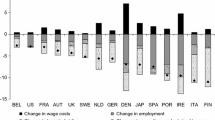Abstract
Albania’s experience with transition is unlike most Eastern European countries. In particular, transition started from a deeply impoverished state, proceeded faster than other countries in the region, and was disrupted by financial sector crises. In addition, Albania experienced extreme population movements both abroad (to as many as twenty different countries) and within the country (from rural areas to major cities). All these changes combined have altered the composition of the local labour force in unknown ways. Understanding who Albania’s unemployed are at present is important for policy decisions, especially given the double-digit unemployment rates of the last decade. In addition, employment stabilization policies in Albania are important from an international perspective, since Albania exports about 15–20% of its labour force to neighbouring countries. This paper uses administrative data from one of the largest, recently established labour offices, to gain insights into the composition and characteristics of Albania’s unemployed.






Similar content being viewed by others
Notes
Although migration data are limited, in 2000 it was estimated that at least 15% of the Albanian population was living abroad. In addition, internal migration resulted in the growth of the urban population from 32% in 1970 to 42% (Albanian Center for Immigration Research 2002). For a description of Albania’s migration during this time, see Kule et al. (1999) and Coulon and Piracha 2003.
See Jarvis (2000) for an overview of the pyramid scheme crisis.
According to the Albanian Central Bank, about 35% of the country’s GDP is generated through informal (underground) activities.
Current law requires that unemployment benefits be paid out for 1 year to those who have paid unemployment insurance for a minimum of 12 months. Payment of unemployment benefits can be extended to 18 months if the person enrolls in training courses (vocational, formal, on-the-job, etc.), and does not receive any other compensation during the training period. People who have substantial assets, especially real estate or land, cannot receive unemployment benefits.
According to surveys by Papapanagos and Sanfey (2001) older Albanians are less likely to emigrate.
References
Albanian Center for Economic Research (2002) “Common country assessment: Albania,” prepared for the United Nations System in Albania, Tirana, http://www.undp.org.al/download/pdf/cca2002.pdf
Coulon A, Piracha M (2003) Self-Selection and the Performance of Return Migrants: the Source Country Perspective. Centre for Economic Performance, London School of Economics and Political Science, Houghton Street, London WC2A 2AE
Hotchkiss L (1993) Effects of training, occupation, and training-occupation match on wage. J Hum Resour 28(3):482–496
Jarvis C (2000) The rise and fall of the pyramid schemes in Albania. IMF staff papers, 47(1)
Korenman S, Neumark D (1991) Does marriage really make men more productive? J Hum Resour 26(2):282–307
Kule D, Mancellari A, Papapanagos H, Qirici S, Sanfey P (1999) The causes and consequences of albanian emigration during transition: evidence from micro-data. European Bank for Reconstruction and Development, Working paper #46
Ministry of Education and Science (2005) National education strategy, 2004–2015. Accessible at: http://www.mash.gov.al
Neuman S, Ziderman A (1991) Vocational schooling, occupational matching, and labor market earnings in Israel. J Hum Resour 26(2):256–281
Neuman S, Ziderman A (1999) Vocational education in Israel: wage effects of the VocEd-occupation match. J Hum Resour 34(2):407–420
Papapanagos H, Sanfey P (2001) Intention to emigrate in transition countries: the case of Albania. J Popul Econ 14:491–504
Acknowledgments
I am deeply indebted to the staff of the Tirana Labour Office for providing the data for this study. All errors are mine.
Author information
Authors and Affiliations
Corresponding author
About this article
Cite this article
Pema, E. Trends in the Albanian Labour Market: Who are Albania’s Unemployed?. Transit Stud Rev 16, 860–871 (2010). https://doi.org/10.1007/s11300-009-0119-5
Received:
Accepted:
Published:
Issue Date:
DOI: https://doi.org/10.1007/s11300-009-0119-5




